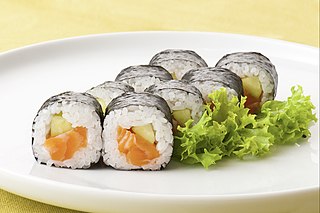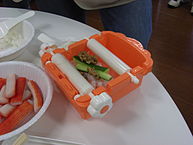
Japanese cuisine encompasses the regional and traditional foods of Japan, which have developed through centuries of political, economic, and social changes. The traditional cuisine of Japan is based on rice with miso soup and other dishes with an emphasis on seasonal ingredients. Side dishes often consist of fish, pickled vegetables, and vegetables cooked in broth. Common seafood is often grilled, but it is also sometimes served raw as sashimi or as sushi. Seafood and vegetables are also deep-fried in a light batter, as tempura. Apart from rice, a staple includes noodles, such as soba and udon. Japan also has many simmered dishes, such as fish products in broth called oden, or beef in sukiyaki and nikujaga.

Nori(Japanese: 海苔) is a dried edible seaweed used in Japanese cuisine, usually made from species of the red algae genus Pyropia, including P. yezoensis and P. tenera. It has a strong and distinctive flavor, and is generally made into flat sheets and used to wrap rolls of sushi or onigiri.

Sushi is a Japanese dish of prepared vinegared rice, usually with some sugar and salt, plus a variety of ingredients, such as vegetables, and any meat, but most commonly seafood. Styles of sushi and its presentation vary widely, but the one key ingredient is "sushi rice", also referred to as shari (しゃり), or sumeshi (酢飯).

Onigiri, also known as omusubi (お結び) or nigirimeshi (握り飯), is a Japanese rice ball made from white rice. It is usually formed into triangular or cylindrical shapes, and wrapped in nori (seaweed). Onigiri traditionally have sour or salty fillings such as umeboshi, salted salmon, katsuobushi, kombu, tarako or mentaiko, or takanazuke. Because it is easily portable and eaten by hand, onigiri has been used as portable food or bento from ancient times to the present day. Originally, it was used as a way to use and store left-over rice, but it later became a regular meal. Many Japanese convenience stores and supermarkets stock their onigiri with various fillings and flavors. It has become so mainstream that it is even served in izakayas and sit-down restaurants. There are even specialized shops which only sell onigiri to take out. Due to the popularity of this trend in Japan, onigiri has become a popular staple in Japanese restaurants worldwide.

Conveyor belt sushi, also called rotation sushi, is a type of sushi restaurant common in Japan. In Australasia, it is also known as a sushi train.

The Chiko Roll is an Australian savoury snack invented by Frank McEncroe, inspired by the Chinese spring roll and first sold in 1951 as the "Chicken Roll" despite not actually containing chicken. The snack was designed to be easily eaten on the move without a plate or cutlery. Since 1995, Chiko Rolls have been made by Simplot Australia.

The history of sushi began with paddy fields, where fish was fermented with vinegar, salt and rice, after which the rice was discarded. The earliest form of the dish, today referred to as narezushi, was created in Japan around the Yayoi period. In the Muromachi period (1336–1573), people began to eat the rice as well as the fish. During the Edo period (1603–1867), vinegar rather than fermented rice began to be used. The dish has become a form of food strongly associated with Japanese culture.

Nyotaimori, often referred to as "body sushi", is the Japanese practice of serving sashimi or sushi from the naked body of a woman. The less common male variant is called nantaimori (男体盛り).

California roll or California maki is an uramaki containing imitation crab, avocado, and cucumber. Sometimes crab salad is substituted for the crab stick, and often the outer layer of rice is sprinkled with toasted sesame seeds or roe.

A spider roll is a type of makizushi sushi that includes breaded or battered soft-shell crab and other ingredients such as cucumber, avocado, daikon sprouts or lettuce, and spicy mayonnaise, rolled inside nori and sushi rice.

A Philadelphia roll is a makizushi type of sushi generally made with smoked salmon, cream cheese, and cucumber, with the rice on the outside (uramaki). It is sometimes made with imitation crab instead of salmon, but can be found to include other ingredients, such as other types of fish, cucumber, scallions, and sesame seed. Like many Western-inspired sushi rolls, its design and name are modified to target an American market, which includes putting the rice on the outside, and the nori in the inside to appeal to western aesthetics.

Japanese cuisine has a vast array of regional specialities known as kyōdo ryōri (郷土料理) in Japanese, many of them originating from dishes prepared using local ingredients and traditional recipes.

Pacific Northwest cuisine is a North American cuisine that is found in the Pacific Northwest, i.e. the states of Oregon, Washington, Idaho and Alaska, as well as the province of British Columbia and the southern portion of the territory of Yukon, reflecting the ethnic makeup of the region, with noticeable influence from Asian and Native American traditions. With significant migration from other regions of the US, influences from Southern cuisine brought by African Americans as well as Mexican-American cuisine as Latinos migrate north from California, can be seen as well.

How Do You Roll? was a franchise fast-casual sushi restaurant, headquartered in Austin, Texas. The first How Do You Roll? location opened in October 2008 and the company began franchising in early 2010. As of April 2016, it had stores operating in California and Florida, but was later closed.
An automated restaurant or robotic restaurant is a restaurant that uses robots to do tasks such as delivering food and drink to the tables and/or cooking the food.

A pancake machine is an electrically-powered machine that automatically produces cooked pancakes. It is believed that the earliest known pancake machine was invented in the United States in 1928. Several types of pancake machines exist that perform in various manners, for both commercial and home use. Some are fully automatic in operation, while others are semi-automatic. Some companies mass-produce pancake machines, and some have been homemade.

Norimaki (海苔巻) are various Japanese dishes wrapped with nori seaweed, most commonly a kind of sushi, makizushi (巻き寿司).

The sushi burrito or sushirrito is a type of Japanese-American fusion cuisine. It is typically prepared by rolling sushi ingredients such as fish and vegetables in a wrap and serving like a burrito. The dish is a form of American cuisine inspired by Japanese cuisine, but is not considered to be authentically Japanese.


















